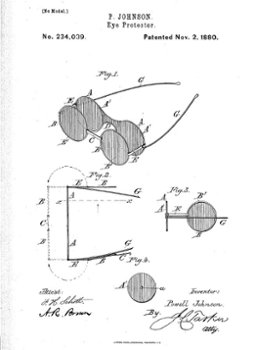Where the History of Vision and Black History Month Cross Paths
Celebrating Black History Month and the African American pioneers who made impacts in the vision industry.
By Ryeá O’Neill & Derek Simon – February 23, 2024
History is everywhere and touches every part of our world and our lives. Some of the most widely known names in history cross paths during the month of February as we celebrate the rich culture of Black History Month.
Earlier this month, we wrote about America’s first black ophthalmologist, Dr. David K McDonough, who broke barriers in a time of heightened racial inequality in the early 19th century. Dr. McDonough’s bravery and ambitious spirit led to people like Dr. William H. Lawson, Powell Johnson, Kenneth J. Dunkley and Dr. Patricia Bath who have impacted things you do and see every day without you even knowing it. They have made great advances in the vision industry and boundaries continue to be broken every day.
William H. Lawson – First African American Optometrist
What better place to start than at the beginning? Dr. William H. Lawson was the first African American to have been licensed to practice optometry in the Unites States and Canada. An optometrist is a doctor who examines the eyes for visual defects, prescribes corrective lenses and sometimes treats diseases of the eyes. Dr. Lawson graduated in 1912 from the Toronto School of Optometry and he set up practice in Detroit in 1916.
By Dr. Lawson’s retirement in the 1950s, there were still only about 100 licensed and practicing Black optometrists in the United States out of the approximately 23,575 registered. This means that only four-tenths of one percent of the practicing optometrists in the United States were African American in the 50’s.
Powell Johnson – The Eye Protector
Powell Johnson was from Barton, Alabama. Not much is known about Johnson’s personal life from the late 1800s; however, he knew that exposure to intense glare and heat was harmful to the eyes and vision, and this spurred him to creative action. On Nov. 2, 1880, he received a patent for an ‘Eye-Protector.’ Johnson thus designed the first Eye-Protector “for use of furnace-men, puddlers (iron manufacturing workers who used a furnace to convert pig iron into wrought iron), firemen, and others exposed to glare of strong light, as well as persons of weak sight,” according to the patent. The protecter had two sets of circular wire frames, separated by a short distance with hinged temples on the inner frame only and semi-opaque cloth disks inserted in both frames to protect the eyes from bright light.

Johnson’s patent is available to read in full online here. The same eyewear was used for persons of weak sight, but inner cloths had pinholes in the center instead of slits, “enabling them to see through the said hole and still have the eye shaded from the light.” Pinhole occluders are still used today and work along the same basis as pupil constriction in bright light, causing an improvement in visual acuity. Johnson is credited with having developed the first functional safety eyewear.
Kenneth J. Dunkley – 3D Glasses
If you were able to watch the movie Avatar in a theatre with 3D glasses, all the credit goes to Kenneth J. Dunkley! Avatar was one of the most recent big blockbuster movies where three-dimension technology was adopted. This was thanks to Kenneth J. Dunkley, who discovered that a two-dimensional picture would appear 3D if two points in a person’s peripheral vision were blocked. This discovery led to future improvements of 3D glasses and the technology we use to view films today. Dunkley revolutionized the way we watch movies.
Born in 1939, Dunkley earned a master’s degree in physics and is known as a visual pioneer and a leader in the field of holography. He is the president of Holospace Laboratories Inc. and conducts visual workshops and the Museum of Scientific Discovery in Harrisburg, Pennsylvania.
Dr. Patricia Bath – First African American Female Ophthalmologist
You may know that when the lens of your eye becomes cloudy it is called a cataract, but do you know who owns the patent for the technology we use today to remove them? Dr. Patricia Bath invented a device and technique known as Laserphaco. This device allows doctors to perform all steps involved in the cataract removal process which includes incision, dismantling of the lens, and the removal of broken pieces. Dr. Bath is recognized as the first black female physician to own a patent and she also co-founded the non-profit, American Institute for the Prevention of Blindness (AIPB) in 1976. Dr. Bath maintained the fundamental belief that “eyesight is a human right.”
Dr. Bath overcame significant hurdles, including sexism, racism, and financial constraints, growing up in Harlem to become the first African American female ophthalmologist. An ophthalmologist is a specialist who evaluates and treats medical and surgical diseases of the eye. Often these specialists can even perform cornea transplants.
Facing a lack of female role models in medicine and barriers to education, she pursued her passion despite societal challenges. In 1993, after retiring from UCLA Medical Center, Dr. Bath became a champion for telemedicine as a solution for healthcare access in rural areas. She passed away in May 2019, leaving behind a legacy of resilience and advocacy for underserved communities.
As you can see (pun intended), there is a rich culture of firsts to explore during Black History Month that have an impact on your vision as you go through each day. Let’s be grateful for the creativity of these inventors and their dedication to making the world a better place for us all.
You can show your gratitude by registering your decision to be an eye donor after death. Giving the gift of sight to another in need is a selfless act and one way, like these historic pioneers, to make the world a better place.
.png?t=20240223120207)